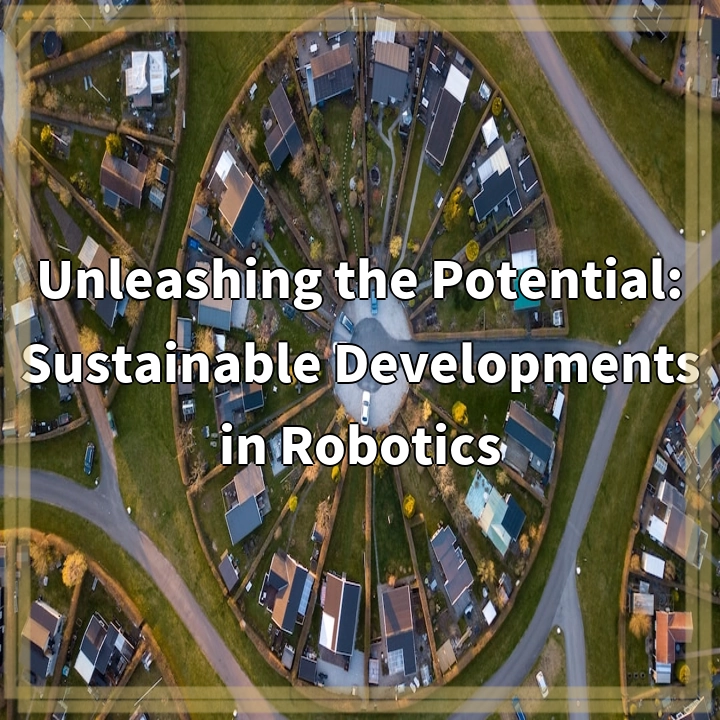
What it is:
Unleashing the Potential: Sustainable Developments in Robotics
In today’s rapidly advancing technological landscape, robotics has emerged as a powerful tool with the potential to drive sustainable development. This innovative field combines the advancements in robotics and automation with sustainability principles to address environmental challenges, improve resource efficiency, and promote social well-being. Sustainable developments in robotics aim to create a harmonious coexistence between humans and machines, paving the way for a more environmentally friendly and equitable future.
Real-World Problems:
1. Environmental Impact:
The adoption of robotics across various industries has the potential to significantly reduce environmental impact. However, the manufacturing and disposal of robots can have negative consequences if not managed properly. The extraction of raw materials, energy-intensive production processes, and electronic waste generated from discarded robots can contribute to pollution, resource depletion, and adverse effects on ecosystems. It is imperative to develop sustainable practices throughout the lifecycle of robotics to mitigate these environmental concerns.
2. Ethical Considerations:
As robots become more integrated into society, ethical challenges arise that need to be addressed. One major concern is the potential displacement of human workers. While automation can improve productivity and efficiency, it can also lead to job losses and economic inequality. Striking a balance between the benefits of robotics and socio-economic impacts is essential to ensure a just and equitable transition to a robotic-enabled future.
3. Privacy and Security:
The increasing use of robotics and automation raises concerns about data privacy and security. Robots are equipped with sensors, cameras, and other data-collecting technologies that can raise privacy issues if misused or inadequately protected. Additionally, the integration of robots into critical infrastructure and systems poses cybersecurity risks. Safeguarding sensitive data and ensuring robust security measures are necessary to build trust and confidence in sustainable robotics technologies.
4. Technological Limitations:
Despite rapid advancements in robotics, there are still technological limitations that hinder the adoption of sustainable practices. Developing robots with enhanced dexterity, adaptability, and decision-making abilities to handle complex and unstructured environments presents ongoing challenges. Overcoming these limitations requires continued research and development, collaboration between academia and industry, and supportive policies that incentivize innovation.
In conclusion, sustainable developments in robotics hold immense potential to address environmental, social, and economic challenges. However, it is crucial to navigate the real-world problems associated with robotics to ensure a responsible and sustainable implementation. By addressing the environmental impact, ethical considerations, privacy and security concerns, and technological limitations, we can unleash the true potential of sustainable robotics and create a better future for all.

Solutions to Real-World Problems in Sustainable Developments in Robotics:
1. Environmental Impact:
To mitigate the environmental impact of robotics, sustainable practices should be implemented throughout the lifecycle of robots. This includes using eco-friendly materials, reducing energy consumption during manufacturing, and promoting recycling and proper disposal methods for end-of-life robots. Collaborative efforts between manufacturers, policymakers, and environmental organizations can drive the development and adoption of sustainable robotics technologies.
2. Ethical Considerations:
Addressing the ethical challenges of robotics requires a holistic approach that balances automation benefits with social impacts. This involves upskilling and reskilling workers to adapt to the changing job landscape, implementing policies that promote fair employment practices, and fostering collaboration between human workers and robots to enhance productivity and job security. Social dialogue and stakeholder engagement are key in finding equitable solutions and ensuring a just transition.
3. Privacy and Security:
To safeguard privacy and security in robotics, robust data protection measures should be implemented. This includes adopting encryption and authentication techniques, regularly updating software and firmware to address vulnerabilities, and implementing access controls to regulate data collection and usage. Raising awareness about privacy rights and promoting transparency in data handling can also enhance trust in sustainable robotics technologies.
4. Technological Advancements:
To overcome technological limitations, continued research and development are crucial. This involves investing in areas such as artificial intelligence, machine learning, and sensor technologies to enhance robot capabilities. Collaboration between academia, industry, and government institutions can accelerate innovation and foster the development of more advanced and adaptable robotics systems. Governments can also play a role by providing support through funding and incentives for technological advancements in sustainable robotics.
By implementing these solutions, we can overcome the challenges associated with sustainable developments in robotics and unlock their full potential. With a focus on environmental consciousness, ethical considerations, privacy and security measures, and technological advancements, we can foster a future where robotics and sustainability coexist harmoniously for the benefit of society and the planet.















